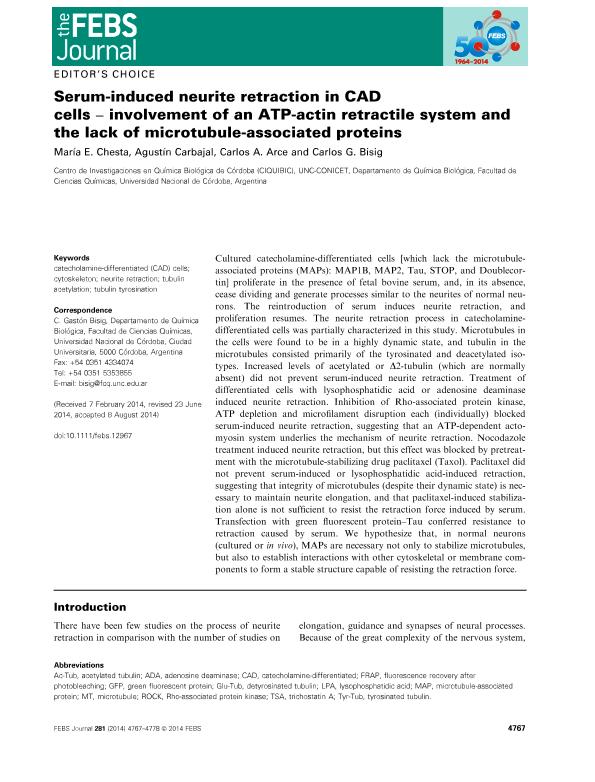Artículo
Serum-induced neurite retraction in CAD cells – involvement of an ATP-actin retractile system and the lack of microtubule-associated proteins
Fecha de publicación:
10/2014
Editorial:
Wiley Blackwell Publishing, Inc
Revista:
Febs Journal
ISSN:
1742-464X
Idioma:
Inglés
Tipo de recurso:
Artículo publicado
Clasificación temática:
Resumen
Cultured catecholamine-differentiated cells [which lack the microtubule-associated proteins (MAPs): MAP1B, MAP2, Tau, STOP, and Doublecortin] proliferate in the presence of fetal bovine serum, and, in its absence, cease dividing and generate processes similar to the neurites of normal neurons. The reintroduction of serum induces neurite retraction, and proliferation resumes. The neurite retraction process in catecholamine-differentiated cells was partially characterized in this study. Microtubules in the cells were found to be in a highly dynamic state, and tubulin in the microtubules consisted primarily of the tyrosinated and deacetylated isotypes. Increased levels of acetylated or Δ2-tubulin (which are normally absent) did not prevent serum-induced neurite retraction. Treatment of differentiated cells with lysophosphatidic acid or adenosine deaminase induced neurite retraction. Inhibition of Rho-associated protein kinase, ATP depletion and microfilament disruption each (individually) blocked serum-induced neurite retraction, suggesting that an ATP-dependent actomyosin system underlies the mechanism of neurite retraction. Nocodazole treatment induced neurite retraction, but this effect was blocked by pretreatment with the microtubule-stabilizing drug paclitaxel (Taxol). Paclitaxel did not prevent serum-induced or lysophosphatidic acid-induced retraction, suggesting that integrity of microtubules (despite their dynamic state) is necessary to maintain neurite elongation, and that paclitaxel-induced stabilization alone is not sufficient to resist the retraction force induced by serum. Transfection with green fluorescent protein–Tau conferred resistance to retraction caused by serum. We hypothesize that, in normal neurons (cultured or in vivo), MAPs are necessary not only to stabilize microtubules, but also to establish interactions with other cytoskeletal or membrane components to form a stable structure capable of resisting the retraction force.
Archivos asociados
Licencia
Identificadores
Colecciones
Articulos(CCT - ROSARIO)
Articulos de CTRO.CIENTIFICO TECNOL.CONICET - ROSARIO
Articulos de CTRO.CIENTIFICO TECNOL.CONICET - ROSARIO
Articulos(CIQUIBIC)
Articulos de CENTRO DE INVEST.EN QCA.BIOL.DE CORDOBA (P)
Articulos de CENTRO DE INVEST.EN QCA.BIOL.DE CORDOBA (P)
Citación
Bisig, Carlos Gaston; Arce, Carlos Angel; Carbajal, Agustin; Chesta, María Eugenia; Serum-induced neurite retraction in CAD cells – involvement of an ATP-actin retractile system and the lack of microtubule-associated proteins; Wiley Blackwell Publishing, Inc; Febs Journal; 281; 21; 10-2014; 4767-4778
Compartir
Altmétricas




